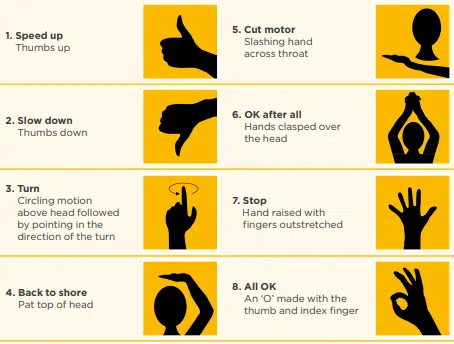10% OFF WITH CODE:
BLACKFRIDAY10
Hand Signals for Water Skiing
March 3, 2023
When towing someone behind a boat or personal watercraft, there must be a spotter on board in addition to the vessel operator. The spotter’s job is to keep an eye on the water skier and communicate with them. With the engine noise, distance and other environmental factors, there is no guarantee that the spotter and skier will be able to communicate verbally. Therefore, hand signals are used to relay basic information.
Before heading out on the water, it’s important to make sure that the driver, spotter and skier are all familiar with the hand signals for water skiing.
Hand signals and their meanings
Image source: Maritime Safety Victoria
- Putting a thumb up means speed up.
- Putting a thumb down means slow down.
- Pointing left with a flat hand means turn left.
- Pointing right with a flat hand means turn right.
- Making a horizontal slashing motion with your hand over your neck means stop/cut the motor.
- Patting the top of your head means return to dock.
- Making the OK hand signal (with your thumb and forefinger forming a circle) means OK/understood.
- Putting your arms up over your head with your hands clasped to form a circle means skier OK after falling into the water.
- Holding your ski(s) up above your head means ready for pickup.
- Holding your ski(s) pointing directly up out of the water means watch out, skier in the water.
- Holding your arm up over your head and making circles means turning the boat around and is usually used by the driver or the spotter.
Learn safe water-skiing practices and more from Drive a Boat Canada
Learn more about water skiing and boating safety with Drive a Boat Canada’s online boating course. Pass the test at the end of the course to obtain your boating license, which is required for all pleasure craft operators in Canada!

